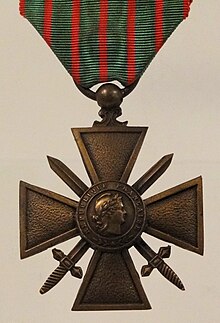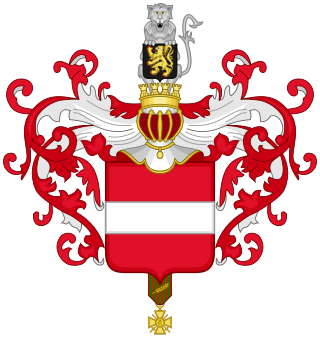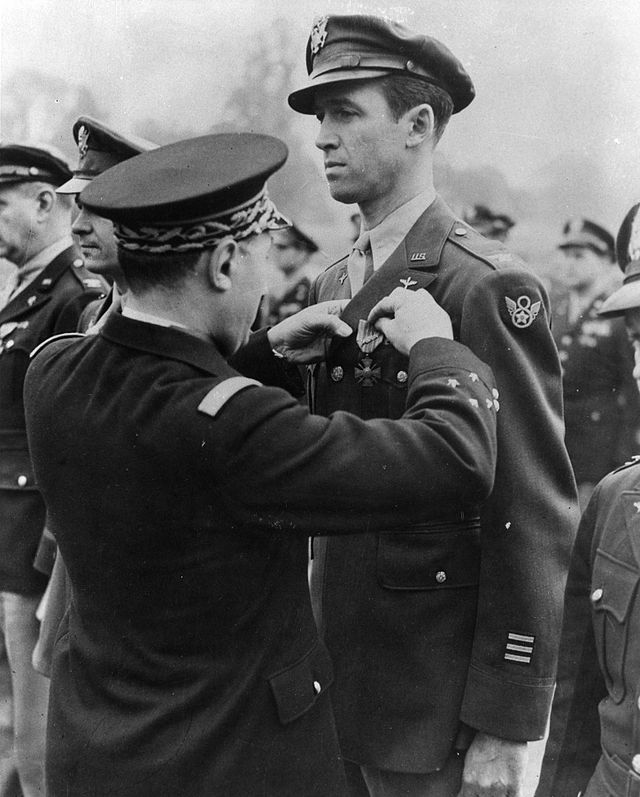Loading AI tools
Military decoration of France From Wikipedia, the free encyclopedia
The Croix de Guerre (French: [kʁwa də ɡɛʁ], Cross of War) is a military decoration of France. It was first created in 1915 and consists of a square-cross medal on two crossed swords, hanging from a ribbon with various degree pins. The decoration was first awarded during World War I, again in World War II, and in other conflicts; the croix de guerre des théâtres d'opérations extérieures ("cross of war for external theatres of operations") was established in 1921 for these. The Croix de Guerre was also commonly bestowed on foreign military forces allied to France.[1]
| Croix de Guerre | |
|---|---|
 | |
| Type |
|
| Awarded for | Individuals who distinguish themselves by acts of heroism involving combat with enemy forces |
| Description | A bronze cross with swords |
| Presented by | |
| Eligibility | Military personnel only, often bestowed to members of allied countries |
| Campaign(s) |
|
| Clasps | None for wars or campaigns; stars and palm denote level of each medal awarded |
| Status | Active |
| Established | April 2, 1915 |
| |
The Croix de Guerre may be awarded either as an individual award or as a unit award to those soldiers who distinguish themselves by acts of heroism involving combat with the enemy. The medal is awarded to those who have been "mentioned in dispatches", meaning a heroic deed or deeds were performed meriting a citation from an individual's headquarters unit. The unit award of the Croix de Guerre with palm was issued to military units whose members performed heroic deeds in combat and were subsequently recognized by headquarters.
The Croix de Guerre medal varies depending on which country is bestowing the award and for what conflict. Separate French medals exist for the First and Second World War.
For the unit decoration of the Croix de Guerre, a fourragère (which takes the form of a braided cord) is awarded; this is suspended from the shoulder of an individual's uniform.
As the Croix de Guerre is issued as several medals, and as a unit decoration, situations typically arose where an individual was awarded the decoration several times, for different actions, and from different sources. Regulations also permitted the wearing of multiple Croix de Guerre, meaning that such medals were differentiated in service records by specifying French Croix de Guerre, French Croix de Guerre (WWI), etc.

There are three distinct Croix de Guerre medals in the French system of honours:
| Ribbon | Awards |
| Croix de guerre 1914–1918 (for World War I service) | |
| Croix de Guerre 1939–1945 (for World War II service) | |
| Croix de guerre des théâtres d'opérations extérieures (TOE), for wars other than World War I and World War II not fought on French soil[note 1] |
Furthermore, the French collaborationist government created two croix during World War II. These croix are now illegal under French law and wearing them is outlawed:
| Ribbon | Awards |
| Croix de Guerre (Vichy France; for World War II service) | |
| Croix de Guerre de la Légion des Volontaires Français (for World War II service) |
The Croix was created by a law of April 2, 1915, proposed by French deputy Émile Briant. The Croix reinstated and modified an older system of mentions in dispatches, which were only administrative honours with no medal accompanying them. The sculptor Paul-André Bartholomé created the medal, a bronze cross with swords, showing the effigy of the republic.
The French Croix represents a mention in dispatches awarded by a commanding officer, at least a regimental commander. Depending on the officer who issued the mention, the ribbon of the Croix is marked with extra pins.
The French Croix de guerre des TOE was created in 1921 for wars fought in theatres of operation outside France. It was awarded during the Indochina War, Korean War, and various wars in the decades that followed. It is the only version of the Croix de Guerre still considered active, though it has not been presented since the Kosovo War in 1999.
When World War II broke out in 1939, a new Croix de Guerre was created by Édouard Daladier. It was abolished by Vichy Government in 1941, which created a new Croix de Guerre. In 1943 General Giraud in Algiers created another Croix de Guerre. Both the Vichy and Giraud Croix were abolished by General de Gaulle in 1944, who reinstated the 1939 Croix.
The Croix de Guerre takes precedence between the Ordre national du Mérite and the Croix de la Valeur Militaire, the World War I Croix being senior to the World War II one, itself senior to the TOE Croix.

The Croix can be awarded to military units, as a manifestation of a collective Mention in Despatches. It is then displayed on the unit's flag. A unit, usually a regiment or a battalion, is always mentioned at the army level. The Croix is then a Croix de Guerre with palm. Other communities, such as cities or companies can be also awarded the Croix.
When a unit is mentioned twice, it is awarded the fourragère of the Croix de Guerre. This fourragère is worn by all men in the unit, but it can be worn on a personal basis: those permanently assigned to a unit, at the time of the mentions, were entitled to wear the fourragère for the remainder of service in the military.
Temporary personnel, or those who had joined a unit after the actions which had been mentioned, were authorized to wear the award while a member of the unit but would surrender the decoration upon transfer. This temporary wearing of the fourragère only applied to the French version of the Croix de Guerre.
The 2nd Battalion Devonshire Regiment of the British Army along with 5 Battery RA were awarded the French Croix de Guerre with palm for its gallant defence of Bois des Buttes on 27 May 1918, the first day of the Third Battle of the Aisne. The Croix de Guerre with palm was also awarded to 2nd Battalion Kings Shropshire Light Infantry for Gallantry near Bligny, part of the Second Battle of the Marne. Several other British Army battalions would receive the award before the end of the war.
In the United States military, the Croix de Guerre was accepted as a foreign decoration. It remains one of the more difficult foreign awards to verify entitlement. The Croix de Guerre unit and individual award were often presented with original orders only and rarely entered into a permanent service record. The 1973 National Archives Fire destroyed most of the World War II personnel records which are needed to verify a veteran's entitlement to the Croix de Guerre award. However, foreign unit award entitlements can be checked and verified through official unit history records. Veterans must provide proof of service in the unit cited at the time of action in order to be entitled to the award. Individual foreign awards can be checked through foreign government (France) military records.
Regarding the United States in WWI, on April 10, 12, and 13, 1918, the lines being held by the troops of the 104th Infantry Regiment, of the 26th "Yankee" Division, in Bois Brûlé, near Apremont in the Ardennes, were heavily bombarded and attacked by the Germans. At first the Germans secured a foothold in some advanced trenches which were not strongly held but, thereafter, sturdy counterattacks by the 104th Infantry - at the point of the bayonet - succeeded in driving the enemy out with serious losses, entirely re-establishing the American line. For its gallantry the 104th Infantry was cited in a general order of the French 32nd Army Corps on April 26, 1918. In an impressive ceremony occurring in a field near Boucq on April 28, 1918, the 104th Infantry's regimental flag was decorated with the Croix de Guerre by French General Fenelon F.G. Passaga. "I am proud to decorate the flag of a regiment which has shown such fortitude and courage," he said. "I am proud to decorate the flag of a nation which has come to aid in the fight for liberty." Thus, the 104th Infantry became the very first American unit to be honored by a foreign country for exceptional bravery in combat. In addition, 117 members of the 104th Infantry received the award, including its commander, Colonel George H. Shelton.[2]
In World War II, the 320th Bombardment Group received the Croix de Guerre avec Palme for action in preparation for and in support of Allied offensive operations in central Italy, April–June 1944. It was the first American unit in this war to be awarded the citation.[3] Members of the 440th AAA AW Battalion (Anti-Aircraft Artillery - Automatic Weapons) of the U.S. Army also received the Croix de Guerre avec Palme (unit award) for stopping the German Ardennes counter-offensive in holding the town of Gouvy, Belgium for 41⁄2 days at the beginning of the Battle of the Bulge on December 16, 1944. Gouvy is midway between St. Vith and Bastogne. Commanding Officer of the 440th, Lt. Col. Robert O. Stone, and Pfc. Joseph P. Regis, also received an individual award of the Croix de Guerre avec Palme. On June 21, 1945, French General De Gaulle presented the following citation to the 34th United States Infantry Division: "A 'division d'elite', whose loyal and efficient cooperation with French divisions, begun in TUNISIA, was gloriously continued throughout the Italian campaign, in particular during the operations of BELVEDERE when the 34th Division, despite the difficulties of the moment, displayed most courageous efforts in support of the operations of the 3rd Algerian Division. This citation bears with it the award of Croix de Guerre with Palm." Soldiers of the US Army 509th Parachute Infantry Regiment "Geronimos" were awarded the Croix de Guerre with Silver Star, For Service in the Southern France campaign. The 369th Infantry Regiment, known as the Harlem Hellfighters by the Germans they killed, were as a unit awarded this medal. 171 members were personally awarded the medal along with the nations highest award, the Legion of Honor. The 509th Unit colors bear the Streamer embroidered "MUY EN PROVENCE".[4]
On March 30, 1951, the President of the French Republic, Vincent Auriol, pinned not only the Croix de Guerre with Palm but also the Legion of Honour on the flag of the Brigade of Midshipmen of the United States Naval Academy in recognition of historic contributions of the Naval Academy, particularly the contributions of alumni to victory in World War II. The flag of the Brigade of Midshipmen does not display streamers for either award, nor do Midshipmen wear the fourragère, despite apparent entitlement to do both.[5]
Today, members of several US Army and Marine Corps units that received the fourragère for combat service during World Wars I and/or II are authorized to wear the award while assigned to the unit. Upon transfer from the unit the individual is no longer authorized to wear the fourragère. Wearing of the decoration is considered ceremonial only and it is not entered as an official military individual or unit award in the service member's permanent service records. Units currently authorized to wear the French fourragère are:


During World War I, Cher Ami, a carrier pigeon with the 77th Division, helped save the lives of 194 American soldiers by carrying a message across enemy lines in the heat of battle. Cher Ami was shot in the chest and leg, losing most of the leg to which the message was attached, and blinded in one eye, but continued the 25-mile flight avoiding shrapnel and poison gas to get the message home. Cher Ami was awarded the French Croix de Guerre with Palm for heroic service. He later died from the wounds received in battle and was enshrined in the Smithsonian Institution.[25]
Aram Karamanoukian, a lieutenant-general of the Syrian army of Armenian descent, who participated in the First Arab-Israeli war, was awarded the Croix de Guerre.[26]
Seamless Wikipedia browsing. On steroids.
Every time you click a link to Wikipedia, Wiktionary or Wikiquote in your browser's search results, it will show the modern Wikiwand interface.
Wikiwand extension is a five stars, simple, with minimum permission required to keep your browsing private, safe and transparent.